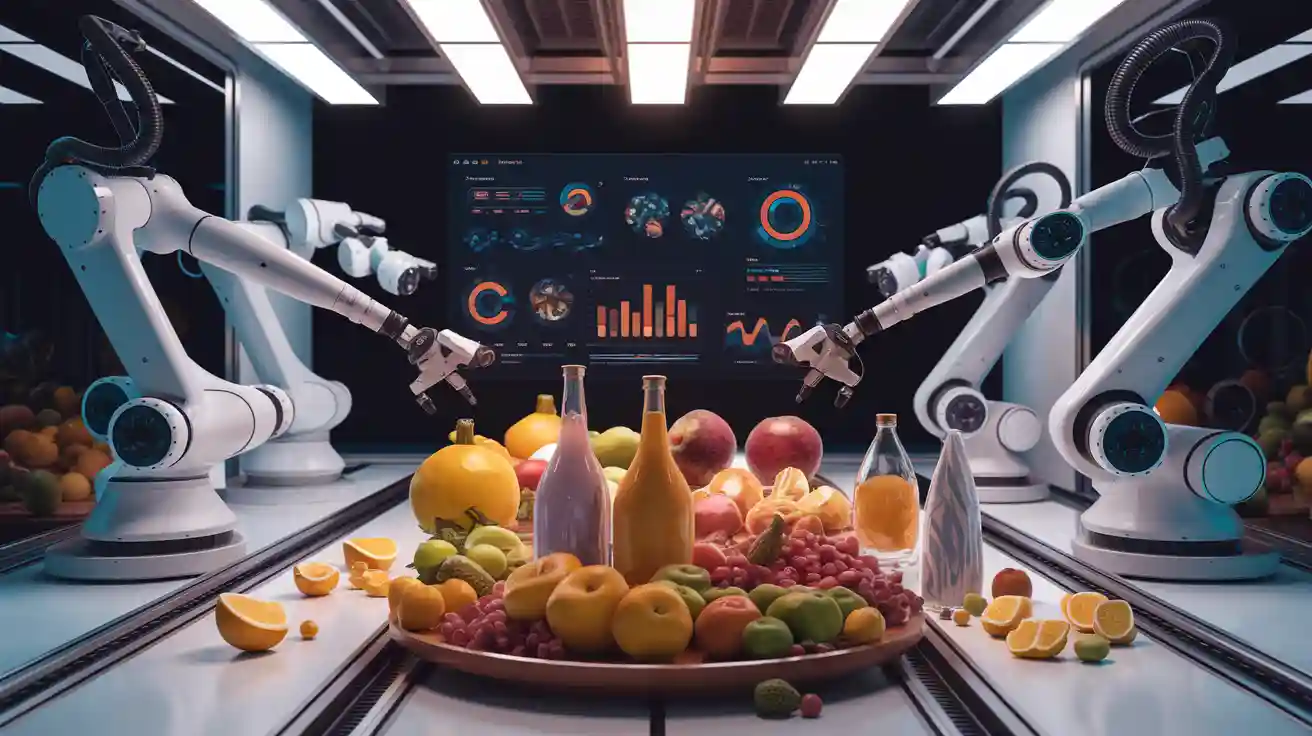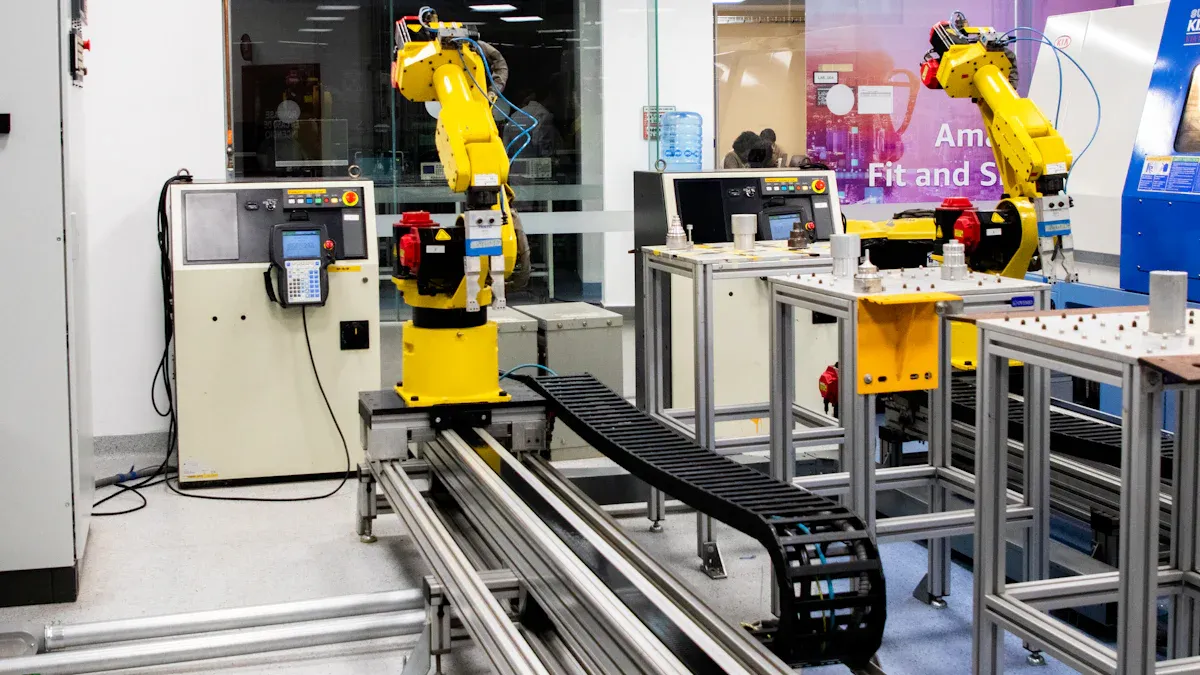3 Key Benefits of Food and Beverage Machine Vision Systems

You face increasing demands to produce high-quality products while maintaining efficiency and safety. A food and beverage machine vision system helps you meet these challenges by automating inspection and control processes. For example, the market for these systems is projected to grow from USD 1.2 billion in 2024 to USD 2.5 billion by 2033, driven by the need for precise quality control. Machine vision system adoption reflects this trend, with software solutions enabling food and beverage manufacturers to reduce errors, improve traceability, and enhance operational performance. These systems are transforming the industry with AI-driven accuracy and reliability.
Key Takeaways
- Using machine vision systems improves checking accuracy, cutting mistakes and costs.
- Automated defect spotting protects health by finding things people might miss.
- Accurate sorting with these systems cuts waste and helps the environment.
- Real-time checks let workers fix issues fast, keeping quality steady.
- These systems meet food safety rules, ensuring trust and following laws.
Improved Quality Control with Machine Vision Systems
Consistent Product Inspection
A food and beverage machine vision system ensures consistent product inspection by automating the process. Unlike manual checks, these systems use AI-powered machine vision to evaluate products with unmatched precision. For instance, adequate lighting conditions account for up to 90% of system performance, while optimized lighting strategies improve defect detection rates by 30%.
| Evidence Description | Impact on Machine Vision Performance |
|---|---|
| Adequate lighting conditions | Account for up to 90% of system performance. |
| Optimized lighting strategies | Improve defect detection rates by 30%. |
By implementing these systems, food and beverage manufacturers can reduce errors and achieve significant cost savings. Averroes.ai reported a reduction in weekly false rejects from 12,000 units to just 246 units, saving over $18 million annually per production line. This level of accuracy ensures that only high-quality products reach your customers.
Detecting Defects and Contaminants
Machine vision inspection excels at defect detection and identifying contaminants in food and beverage products. These systems evaluate over 99% of visual material, ensuring thorough quality inspection. They can detect tiny flaws or contamination that human eyes might miss, safeguarding public health and enhancing brand reputation.
| Statistic | Description |
|---|---|
| 99% | Machines evaluate over 99% of video/image material for corporate use. |
| Flaw Detection | Identifies tiny flaws undetectable by the human eye, ensuring safety compliance. |
| Contamination Detection | Detects contamination early, protecting public health. |
Automated visual inspection also reduces labor costs by streamlining sorting, grading, and inspection operations. This efficiency allows you to maintain high standards while minimizing expenses.
Reducing Waste Through Accurate Sorting
Accurate sorting is another key benefit of a machine vision system. AI-based visual inspection ensures that products are sorted correctly, reducing waste and improving cost efficiency. These systems maintain a good-to-bad sorting ratio of 1.5–2:1, which minimizes errors and enhances resource utilization.
| Performance Metric | Description |
|---|---|
| Good-to-bad sorting ratio | Systems maintain a ratio of 1.5–2:1. |
| Increased accuracy | Enhances sorting accuracy, reducing waste. |
| Environmental benefits | Promotes a circular economy by reducing landfill waste. |
By improving sorting accuracy, these systems contribute to better waste management. They reduce the amount of waste sent to landfills, lower greenhouse gas emissions, and conserve natural resources. This not only benefits the environment but also supports your business's sustainability goals.
Enhancing Operational Efficiency in Food and Beverage

Faster Production Line Speeds
Integrating a food and beverage machine vision system into your production line significantly boosts efficiency. These systems execute repetitive tasks with high precision and without interruptions, reducing downtime and eliminating the need for manual inspections. For example, machine vision systems adapt to higher speeds to meet global demand. Faster cameras and innovative lighting solutions ensure high-quality image acquisition, even at rapid production rates.
| Improvement Aspect | Description |
|---|---|
| Speed Adaptation | Machine vision systems adapt to higher speeds to meet increasing demand. |
| Camera Speed | Faster cameras maintain accuracy while speeding up production lines. |
| Lighting Innovation | Advanced lighting ensures clear images for accurate inspections. |
By automating tasks like product sorting and defect detection, these systems enhance productivity and reduce delays. This allows you to meet tight deadlines while maintaining quality control.
Minimizing Human Error
Machine vision systems reduce human error by capturing detailed information about food products. These systems use AI-powered machine vision to improve monitoring accuracy and ensure consistent results. For instance, an automatic mango sorting method achieved a detection efficiency of 97.88% and an accuracy of 88.75%. Another system used industrial cameras and deep learning to track food adulteration, showcasing the effectiveness of machine vision inspection in food safety.
- Machine vision systems capture detailed product data, improving accuracy.
- AI-based visual inspection ensures consistent results, reducing errors.
- Advanced detection methods enhance food safety and quality control.
By minimizing human error, you can maintain high standards and protect your brand reputation. This also reduces the risk of costly recalls and ensures compliance with industry regulations.
Real-Time Monitoring and Adjustments
Real-time monitoring is a game-changer for food and beverage manufacturers. Machine vision systems analyze visual data to detect anomalies, such as equipment malfunctions or misaligned parts. Immediate corrective actions minimize disruptions and optimize workflows. For example, production line monitoring identifies defects early, while downtime monitoring assesses machinery performance to prevent unexpected breakdowns.
| Application | Description | Impact on Production Processes |
|---|---|---|
| Raw Material Inspection | Verifies size and specifications of incoming materials. | Prevents defects and ensures quality before production begins. |
| Production Line Monitoring | Analyzes visual data to detect anomalies like equipment malfunctions. | Enables immediate corrective actions, minimizing disruptions. |
| Assembly Line Monitoring | Detects incorrect part placements or misalignments. | Enhances product quality and optimizes workflows. |
| Heat Treatment Process Monitoring | Monitors furnace temperatures and compliance with heating cycles. | Ensures material quality and reduces process deviations. |
| Production and Downtime Monitoring | Assesses machinery performance and condition in real-time. | Facilitates predictive maintenance, reducing unexpected breakdowns. |
With real-time adjustments, you can maintain consistent production quality and avoid costly delays. This level of automation ensures that your operations run smoothly and efficiently.
Ensuring Regulatory Compliance and Safety with Machine Vision
Meeting Food Safety Standards
A food and beverage machine vision system plays a vital role in helping you meet stringent food safety standards. These systems perform precise inspections to ensure that every product complies with regulatory requirements. For example, machine vision inspection can detect contaminants, improper packaging, or labeling errors that might otherwise go unnoticed. By automating these processes, you can maintain consistent quality control and reduce the risk of non-compliance.
Machine vision systems also enhance food detection capabilities. They identify foreign objects or defects in raw materials, ensuring that only safe and high-quality products proceed to the next stage of production. This level of accuracy not only protects public health but also safeguards your business from potential legal issues.
Traceability and Documentation
Traceability is essential for food and beverage manufacturers to maintain transparency and accountability. A visual inspection system enables you to track products throughout the production process. By capturing detailed data at every stage, these systems create a digital record that simplifies compliance with traceability regulations.
For instance, machine vision systems can monitor packaging codes, batch numbers, and expiration dates with unmatched precision. This ensures that all products are correctly labeled and traceable in case of any issues. The automation of documentation reduces manual errors and saves time, allowing you to focus on other critical aspects of your operations.
Preventing Recalls and Ensuring Consumer Trust
Machine vision systems act as critical checkpoints in your production process. They meticulously oversee operations to prevent errors that could lead to costly recalls. By identifying minute imperfections in sealing, labeling, or packaging, these systems ensure that your products meet safety standards and consumer expectations.
Tip: Vision AI helps detect packaging seal defects proactively, reducing the risk of recalls and protecting your brand reputation.
| Evidence | Description |
|---|---|
| Enhanced Quality Control | Machine vision systems improve manufacturing quality and performance. |
| Defect Detection | These systems identify defects in products and packaging. |
| Compliance Assurance | Machine vision ensures regulatory compliance, fostering consumer trust. |
By integrating AI-powered software, you can enhance quality control and maintain consumer confidence. These systems not only prevent defective products from reaching the market but also demonstrate your commitment to safety and reliability.
A food and beverage machine vision system transforms your operations by improving quality control, enhancing efficiency, and ensuring compliance. AI-powered automation reduces manual labor and operational costs, allowing you to focus on strategic tasks. These systems optimize inspection processes, minimize errors, and streamline production workflows. By adopting this technology, food and beverage manufacturers can scale operations, reduce waste, and meet growing demands without significant expenses.
Machine vision systems also improve packaging accuracy and traceability, fostering consumer trust. AI-driven software analyzes data to identify cost-saving opportunities and mitigate risks, helping you maintain a competitive edge. Investing in these systems ensures your business stays ahead in a rapidly evolving industry.
FAQ
What is a food and beverage machine vision system?
A food and beverage machine vision system uses cameras and AI to inspect products during production. It automates tasks like defect detection, sorting, and quality control. This ensures consistent product quality and reduces errors.
How does machine vision improve food safety?
Machine vision detects contaminants, packaging errors, and defects with high precision. It ensures compliance with food safety standards by identifying issues early. This protects consumers and prevents recalls.
Can machine vision systems reduce production costs?
Yes, these systems minimize waste, reduce labor costs, and improve efficiency. By automating inspections and sorting, you can save resources and optimize production processes.
Are machine vision systems difficult to integrate?
Most systems are designed for easy integration into existing production lines. Manufacturers provide support for setup and customization, ensuring a smooth transition.
What industries benefit most from machine vision systems?
Industries like food processing, beverage production, and packaging benefit greatly. These systems enhance quality control, improve safety, and streamline operations in high-demand environments.
Tip: Start small by integrating machine vision into one production stage. Expand as you see results!
See Also
The Impact of Agricultural Machine Vision Technology
A Comprehensive Guide to Electronic Machine Vision
The Importance of Machine Vision in Measuring Volume
